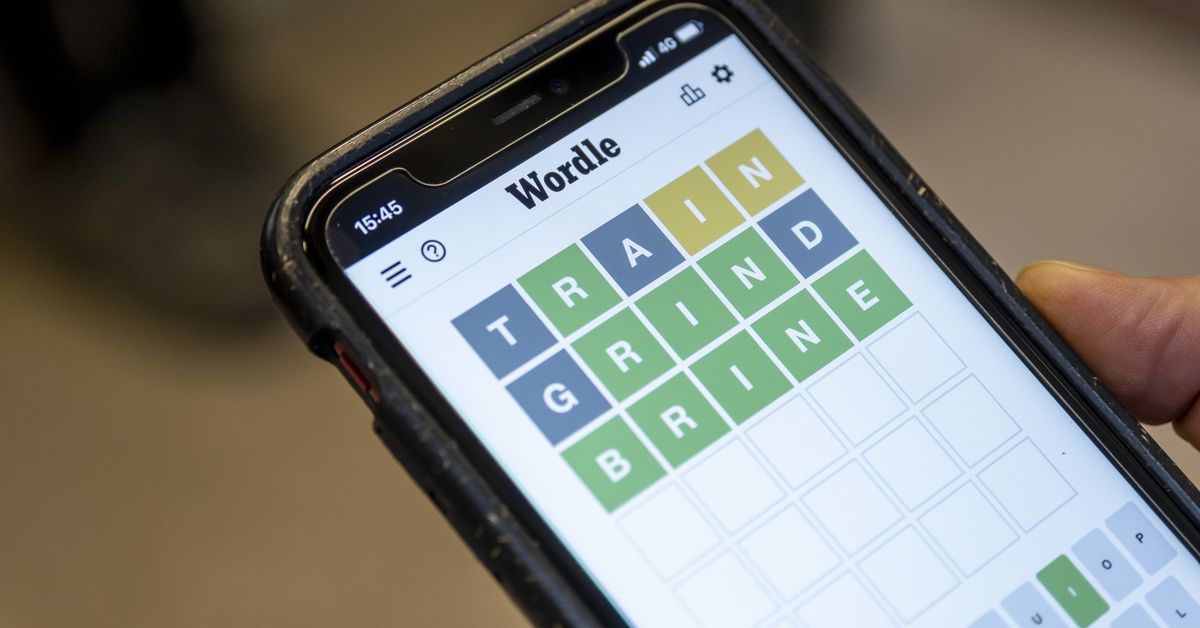The Verge’s 13 favorite kitchen tools
The VergeWe’ve all got to eat, and unless you’re the type of person who lives on instant meals and takeout, you probably need to cook as well. Most of The Verge’s staff not only cook but enjoy cooking, so...
/cdn.vox-cdn.com/uploads/chorus_asset/file/24543248/Favorite_kitchen_gadgets.jpg)
We’ve all got to eat, and unless you’re the type of person who lives on instant meals and takeout, you probably need to cook as well. Most of The Verge’s staff not only cook but enjoy cooking, so we asked them to tell us what type of kitchen tools they are using these days.
We got a wide variety of answers — and at least one debate. We have recommendations for instant thermometers, rice cookers, and toaster ovens as well as a back-and-forth about the best way to grind your coffee beans, and more.
So check out how our writers and editors hone their foodie skills, and if you like, let us know in the comments what your favorite kitchen tool is. (And if you’re really into this kind of thing, feel free to check out last year’s favorite kitchen gadgets.)
Making coffee
Two opinions on coffee grinders
Back in June 2020, my partner and I decided to get serious about our coffee and buy a grinder. We wanted one that would grind enough beans for a full day of coffee for two caffeine-addicted people and would accommodate the coarse grind we needed for our French press. Not being high-level aficionados, we also didn’t want to invest too much of our savings into the purchase.
We finally decided on the Capresso Infinity Conical Burr Grinder, which, at the time, cost about $85 and offered steel conical burrs and a wide range of grinds. And we haven’t regretted our choice — since then, it has been working away on a nearly daily basis, and as far as I can tell, continues to deliver well-ground coffee. It doesn’t have some of the extras that more expensive grinders come with, such as a hopper that holds a week’s worth of coffee or a timer that automates how many beans are ground. In addition, it can be a bit difficult to clean at first because of the grounds that clung to the works afterward due to static buildup. However, I’m happy to store my coffee separately, I’m perfectly capable of weighing out how many beans I need for each grind, and flicking a few drops of water into the beans takes care of the “static cling.”
Finally, I want to mention the product support. About a year and a half after I bought the grinder, I dropped and broke its plastic hopper. I called the company, a person answered the phone, told me that of course they could replace the hopper, emailed me a link to where I could order it, and for a very reasonable price, the hopper was delivered within the week. Being used to getting the runaround from a variety of tech companies, I was pretty impressed. – Barbara Krasnoff, reviews editor
At the risk of starting a coffee grinder war (because when it comes to fighting about coffee, we’re all losers), I’d like to recommend an alternative model for anyone prepared to pay slightly more — the Wilfa Uniform. I’ve been using the European version of this grinder for a while now, and now, there’s finally a model available for North America.
Now, just to see off the obvious complaint: yes, the Wilfa Uniform is over double the price of Barbara’s pick. I haven’t done a side-by-side comparison, and I can’t tell you whether there’s a night and day difference between the two grinders.
But what I can say is that I’ve had no complaints with the Wilfa Uniform after using it twice a day for the better part of two years. There are a couple dozen different grind settings depending on whether you want finer coffee for pour-overs or a coarser grind for something like a French press, and once you tip the beans in, you just press the button on the front of the machine once to get it going. It’ll automatically shut off when all the beans are pulverized.
And, reader, I love it. I’m able to make tasty coffee with the beans I grind in it, and when I’m not using it, it sits discreetly on my countertop without getting in the way. Despite Wilfa’s advertising, its flat burrs won’t do an amazing job at grinding super fine for espresso, but it handles pour-overs, moka pots, and the AeroPress just fine.
If you’d like a more in-depth look at the grinder, then coffee YouTuber James Hoffmann has done a couple of videos on it over the years. Just be aware that, from what I can tell at least, the version of the grinder that Lardera is selling in the US doesn’t appear to come with the built-in set of scales you’ll see in Hoffmann’s videos. – Jon Porter, reporter
A needlessly expensive milk frother
Somehow, I became a person who makes fussy coffee, which was a huge mistake. (My father-in-law, who makes a pot of coffee on Monday and just reheats and drinks it for the next four days, has it right.) But when I finally owned a good grinder, a lovely Chemex, and a stupidly expensive bag of beans, there was only one thing left to do: find a way to froth the milk at the level of my neighborhood coffee shop. Well, that or buy a $5,000 espresso machine, but I’m still working up to that.
I’ve tried hand frothers in the past, but those don’t work well or hold up very long. So I ended up with the Miroco Milk Frother, which is big, about $50, and literally doesn’t do anything other than warm up a serving of milk at a time. But I love it. It makes even the dregs of a pot of coffee feel (and taste) fancy, it’s easy to clean, and it does its job with just one press of a mushy button on the side. I’ve even started making tea lattes, which is a perfect afternoon treat. Give me a few more weeks, and I’m gonna be pouring fancy latte art because what fun is coffee if it doesn’t take 20 minutes to prepare? – David Pierce, editor-at-large
Counter cooking
A multipurpose rice cooker
A lot of people will tell you that rice cookers are single-use appliances meant only for rice — they’re wrong. A rice cooker is best at cooking rice, but it can do a lot of the same things as an Instant Pot. For instance, you can use it to cook hardboiled eggs or oatmeal, steam vegetables, make porridge, make one-pot meals, and even bake a cake.
I grew up with giant 10-cup rice cookers at home, but I didn’t appreciate how versatile this appliance was until I left the country for college. A tiny two-cup rice cooker kept me fed in my cramped 250-square-foot Tokyo apartment. It was programmable, so I could wash my rice, stick it in the cooker, and know that when I woke up late for class, I could still whip up some ochazuke or oatmeal for a quick, cheap, and nutritious breakfast. (It also took the hassle out of steel-cut oats.) Whenever I had a craving for sweets, it was so easy to take pancake mix and bake a Japanese-style cheesecake for one.
I’ve since graduated to a 5.5-cup Zojirushi Micom Rice Cooker, and it’s one of the handiest tools I have for meal prepping. When I was sick this past winter, I made ample use of its porridge setting to make a congee-type dish with chicken and ginger — just like my mom used to make when I was a kid. The fact that it’ll keep something warm for days, meant I could crawl out of bed, scoop out some porridge, and crawl back into bed with minimal effort. When I’m feeling lazy, I throw eggs in there, and bam — some extra hard-boiled protein. Mine also comes with a little basket, so it’s super easy to throw in veggies or steam frozen dumplings.
But what I like most is that rice cookers are more space-efficient than Instant Pots. In my kitchen, the one spot where I could fit an Instant Pot is instead occupied by a rice cooker, blender, and spoon rest. A multitasking kitchen gadget that doesn’t take over your entire counter? That’s a must if you live in a small space. – Victoria Song, reviewer
Old-fashioned toaster ovens
I love a toaster oven! It’s compact, works fast, and is perfect for reheating pizza, making nachos, and yes, even toast. I use my toaster oven more than my regular oven for sure — and probably more than any other item in my kitchen. I have a pretty basic model like this one, but these days, many come with other features, like air frying and convection oven capabilities. – Amelia Holowaty Krales, senior photo editor
I second the usefulness of a toaster oven. Our fancy, relatively new oven recently developed problems, and while we are waiting for the parts to be shipped, we are doing all our cooking using our old-fashioned toaster oven. No, we can’t produce any large eight-serving casseroles or whole chickens, but we’ve been able to cook four chicken thighs or other reasonably sized portions for the two of us just fine. – Barbara Krasnoff
Even more old-fashioned toasters
When I want toast or a perfect steaming frozen waffle, I go old-school these days — with a big two-slot chrome toaster invented in 1949 that’s arguably still the best ever made. As Technology Connections (and I) have famously explained, the Sunbeam Radiant Control Toaster can’t be beat: it automatically lowers, raises, and toasts your bread by temperature rather than time using simple mechanical principles rather than motors or computer chips. It can be pricey on eBay, but if you see one at a thrift store or estate sale, don’t hesitate: even ones that don’t light up are often a super easy fix. – Sean Hollister, senior editor
Boasting about blenders
Okay, someone had to do it. If you’ve ever looked up cooking gear on the internet, you’ve almost certainly come across herds of Vitamix devotees who tell you about just how great their expensive blenders are. “They make the smoothest smoothies,” they’ll say. “I can even make my own nut butter.” And of course, they’ll never miss a chance to tell you that you can make hot soup in it.
I’m sorry to say that I am also one of those people now. My last blender was a $20 Oster that I killed making hummus (my Vitamix makes great hummus, by the way), but I’ve also used more expensive ones from the likes of Ninja and Nutribullet. And I’m here to tell you that, yes, if you use a blender on a daily or weekly basis, the Vitamix really is worth its not insubstantial price premium. It turns out that when I have a nice blender, I actually use it; I went from drinking smoothies once or twice a month to making them every day. I’ve also used the Vitamix to crush peanuts, make almond flour, whip up some milkshakes, and even to turn regular sugar into powdered sugar when I found myself in a pinch.
What I’m saying is that I’ve absolutely gotten my money’s worth, and I’m only four months into the seven-year warranty period. And just to be clear, you don’t have to buy a top-of-the-line Vitamix to get all the benefits that come with the brand’s blenders; mine was $300 on sale at Costco, and you can get a similar one for even less if you’re willing to shop at the company’s certified reconditioned store. – Mitchell Clark, news writer
A kitchen workhorse
My general philosophy on kitchen gadgets is they’re often more hassle than they’re worth —finding a place to store them, cleaning them, lugging them onto the counter when you do use them — in other words, not always worth it. But then, I met the Thermomix TM6, and it was love at first bite.
This kitchen workhorse quite literally does it all, bar the baking. In its simplest form, it’s a blender that can cook, but it can also chop, whisk, steam, sauté, knead, and double as a kettle, a sous vide cooker, a rice cooker, and a slow cooker. There are various accessories you can add to do more — such as for peeling and fancier chopping — but for me, less is more, and this blender does a whole lot more than my old Oster.
It also costs a whole lot more, clocking in at a whopping $1,499 — but trust me, it’s worth it. It’s like having an extra pair of hands in your kitchen. And thanks to its self-contained design, cleanup is minimal. (It can even clean itself.)
My favorite feature is the built-in scale, so no more need to weigh and measure ingredients — just chuck ’em in, and the little Android touchscreen display shows when you have the right amount. (Getting the wrong amount is a little hard to walk back, though.) The screen also walks you through cooking everything from hollandaise sauce and mashed potatoes to meatballs and minestrone. (This does require an annual subscription, but you can use the gadget without one.)
If you want to hear me wax even more lyrical about this gadget and cook up a turkey dinner using basically just the Thermomix and my oven, check out this Vergecast episode. (Be prepared to be hungry!) – Jennifer Pattison Tuohy, reviewer
Helpful gadgetry
Fast and accurate thermometer
Until this year, I had a collection of variously aged dial thermometers collecting at the back of a kitchen drawer. I didn’t trust any of them for an accurate reading, and when trying to divine whether the Thanksgiving turkey was actually done or just faking, I would have to wait patiently for a reading and then guess which one was right. I finally upgraded to a Thermapen One, a nice little gadget that is the only truly “instant” thermometer I’ve ever cooked with.
My Thermapen has made it dramatically easier to tell when something is finished cooking, which I’ve done successfully with breads, meats, and even a boiling caramel. I also love the simple but nice design. It has zero buttons; you simply fold the probe out to turn the thermometer on and then fold the probe down for storage. Highly recommend for you or the cook in your family! – Helen Havlak, publisher
I second this recommendation — I have a slightly older Thermapen and never cook meat, but it’s still a kitchen essential for me. I use it all the time for making candy or finicky frostings or even just to see how hot the water I’m trying to cook with is. – Mitchell Clark
A good spider
Very few kitchen tasks are as annoying as trying to get something out of boiling water or oil without a proper utensil. Rubber or plastic slotted spoons have their place, but when I need to fish something out of extremely hot liquid, I almost always reach for my spider instead. For one, I never have to worry about the metal basket melting, something I have an irrational fear about. The wide basket is also just really good at picking things up, meaning I get the job done faster. – Mitchell Clark
Keep dishes clean
Okay, let me get this out of the way: yes, the name (the Scrub Daddy) is mildly weird, and yes, it is slightly uncomfortable to clean your dishes with something that has a face (especially since you’re supposed to put your fingers through the eye holes to really get a good grip on it). But all of those concerns are wiped away by just how good this sponge is. Its main trick is its “FlexTexture” foam that changes firmness depending on the temperature of the water you’re using. If the thing you’re cleaning is delicate or requires some amount of dexterity, you can use warm water to make the Scrub Daddy soft and easy to work with. But the moment you come across something that’s stubbornly stuck on, you can run the sponge under cold water to make it firm up, to the point where it almost feels like steel wool.
I don’t think I’d ever have the Scrub Daddy as my only sponge (the same’s true for the Scrub Mommy, which is half FlexTexture and half more traditional sponge material) just because I’m so used to the yellow Scotch-Brite’s form factor, but I always keep one in the kitchen for when the scrubbing gets tough. – Mitchell Clark
Seal in your fresh food
I never knew how much I needed a vacuum sealer until I actually got one. I’m the type of person who shops at wholesale clubs despite only needing food for two people, so when I buy meat, I get a lot of it all at once, some of which inevitably gets stored in my fridge or freezer. That’s where my vacuum sealer comes in.
While I can’t speak to the quality of other vacuum sealers, the FoodSaver I have is awesome. Not only does the thing help keep raw meat and other food fresher for longer in the fridge but it also helps save space in the freezer (each package of meat becomes much flatter when all the air is sucked out of it). With this little machine, I can load up whatever I want in one of the FoodSaver bags, insert the open end into the machine, which vacuums up all the air and then closes the bag using its heat sealing feature in one fell swoop. It’s pretty neat! – Emma Roth, weekend news editor

 JaneWalter
JaneWalter 
































